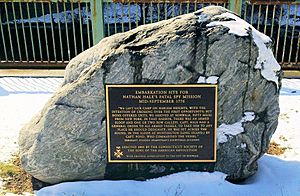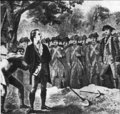Nathan Hale facts for kids
Quick facts for kids Nathan Hale |
|
|---|---|
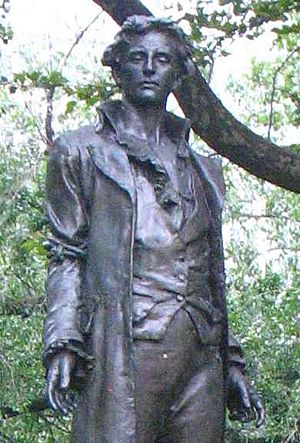
Nathan Hale, by Frederick MacMonnies, City Hall Park, New York
|
|
| Allegiance | |
| Active | 1775-1776 |
| Rank | Corporal (militia) |
| Operation(s) | American Revolutionary War |
|
|
|
| Born | June 7, 1755 Coventry, Connecticut Colony, British America |
| Died | September 22, 1776 (aged 21) British-occupied New York City |
| Cause of death |
Execution by hanging |
| Nationality | British subject (1755-1776) American (1776) |
| Parents | Richard Hale Elizabeth Strong |
| Occupation | Soldier Spy |
| Alma mater | Yale College |
Nathan Hale (born June 6, 1755 – died September 22, 1776) was an American hero during the American Revolutionary War. He was a soldier and a spy for the Continental Army, which was the army of the American colonies fighting for independence.
Nathan Hale bravely volunteered for a secret mission to gather information in New York City. However, he was captured by the British army and sadly executed. Today, Nathan Hale is remembered as a great American hero. In 1985, he was officially named the state hero of Connecticut.
Contents
Nathan Hale's Early Life and Family
Nathan Hale was born in Coventry, Connecticut, in 1755. His parents were Deacon Richard Hale and Elizabeth Strong. He came from a family with a long history in America.
In 1769, when Nathan was 14 years old, he and his older brother Enoch went to Yale College. At Yale, Nathan was classmates with Benjamin Tallmadge, who also became a spy for the American side. The Hale brothers were part of a group called the Linonian Society. They debated many interesting topics, like astronomy, math, and literature.
Nathan graduated from Yale in 1773 when he was 18. He finished with top honors. After college, he became a teacher. He taught first in East Haddam, Connecticut, and later in New London, Connecticut.
Nathan Hale and the American Revolutionary War
When the American Revolutionary War started in 1775, Nathan Hale joined a Connecticut militia group. Within five months, he was chosen as a first lieutenant. His group took part in the Siege of Boston, but Nathan stayed behind at first.
Some people think he wasn't sure about fighting, or maybe his teaching contract kept him from joining right away. On July 4, 1775, his friend Benjamin Tallmadge wrote to him. Benjamin encouraged Nathan to join the fight, saying it was for their "holy Religion, the honor of our God, a glorious country, & a happy constitution."
This letter inspired Nathan. A few days later, he became a first lieutenant in the 7th Connecticut Regiment. This regiment was led by Colonel Charles Webb.
Nathan Hale also became part of Knowlton's Rangers. This was the first organized group for gathering secret information for the United States of America. It was led by Lieutenant Colonel Thomas Knowlton.
In the spring of 1776, the Continental Army moved to Manhattan Island to protect New York City from the British. In August, the British strongly defeated the Americans in the Battle of Long Island. General George Washington desperately needed to know where the British would attack Manhattan next. He asked for a volunteer to go behind enemy lines as a spy. Nathan Hale was the only one who stepped forward.
-
Nathan Hale's commission as captain in the Nineteenth Regiment of foot. Signed by John Hancock.
-
A bronze statue of Nathan Hale (1890) by Frederick William MacMonnies at the Brooklyn Museum.
Nathan Hale's Secret Mission
On September 8, 1776, Nathan Hale volunteered for the dangerous mission. He knew that spying was an act punishable by death. On September 12, he was taken by boat across the Long Island Sound to Huntington, New York. This area was controlled by the British.
Nathan planned to pretend to be a Dutch schoolteacher looking for work. However, he didn't use a fake name. He reportedly carried his Yale diploma, which had his real name on it.
While Nathan was undercover, New York City fell to British forces on September 15. General Washington had to retreat to the northern part of Manhattan. Shortly after, on September 21, a large part of lower Manhattan burned in the Great Fire of New York (1776).
After the fire, the British arrested over 200 American Patriots for questioning.
One story of Nathan Hale's capture comes from Consider Tiffany, a shopkeeper who supported the British. Tiffany wrote that Major Robert Rogers of the Queen's Rangers saw Nathan in a tavern and recognized him. Rogers tricked Nathan into revealing he was a Patriot. Then, Rogers and his Rangers arrested Nathan near Flushing Bay in Queens, New York. Another story says that Nathan's cousin, Samuel Hale, who supported the British, was the one who told on him.
British General William Howe had his headquarters in the Beekman House in Manhattan. Nathan Hale was reportedly questioned by General Howe. Evidence was found on him, and Rogers provided information about the case. Some say Nathan spent the night in a greenhouse at the mansion, while others say it was a bedroom.
Nathan asked for a Bible, but his request was denied. He also asked for a clergyman, but this was also denied. General Howe did allow him to write letters. He wrote one to his brother Enoch and another to his commanding officer. But the next day, a British officer tore them up in front of him.
Nathan Hale's Death and Famous Last Words
At that time, spies were usually hanged as illegal combatants. Nathan Hale acted very bravely before his execution. A British officer named Frederick MacKensie wrote in his diary that Nathan "behaved with great composure and resolution." He said that every good officer should obey their commander and that people should always be ready to face death.
On the morning of September 22, 1776, Nathan Hale was marched to the Park of Artillery. This was near a public house called the Dove Tavern (around modern-day 66th Street and Third Avenue). There, he was hanged. He was only 21 years old.
No official records were kept of Nathan Hale's final speech. But it is widely believed that his last words were: "I only regret that I have but one life to lose for my country." This quote comes from British Captain John Montresor, who was at the hanging. The next day, Montresor spoke with American Captain William Hull. Hull later wrote in his memoirs what Montresor told him:
"On the morning of his execution," the officer said, "my station was near the fatal spot... Captain Hale entered: he was calm, and bore himself with gentle dignity... He asked for writing materials... He was shortly after summoned to the gallows. But a few persons were around him, yet his characteristic dying words were remembered. He said, 'I only regret, that I have but one life to lose for my country.'"
Since Captain Hull wasn't there himself, some historians wonder if this account is completely accurate.
Over the years, people have wondered if Nathan Hale really said this exact line. It's possible he was repeating a line from a popular play called Cato by Joseph Addison. Many American Patriots were inspired by this play. One line from the play says:
How beautiful is death, when earn'd by virtue!
Who would not be that youth? What pity is it
That we can die but once to serve our country.
It's very likely that Nathan Hale's last speech was longer than just one sentence. Early accounts mention other things he said. For example, his brother Enoch wrote in his diary that Nathan said he was a "Capt in the Cont Army by name Nathan Hale." Another newspaper from 1777 said he made a "sensible and spirited speech" and told them they were killing an innocent person. It also said he wished he had "ten thousand lives" to give for his country.
There are a few places in Manhattan that claim to be where Nathan Hale was hanged:
- City Hall Park, where a statue of Hale was put up in 1890.
- Inside Grand Central Terminal.
The Yale Club has a plaque that says the event happened "near" the club. Yale was Nathan Hale's college. The club is very close to Grand Central Terminal. Another story says he was executed at Bergen Beach, Brooklyn, but there is no proof for this.
Nathan Hale's body was never found. His family built an empty grave marker, called a cenotaph, in Nathan Hale Cemetery in South Coventry Historic District, Connecticut.
Nathan Hale's Legacy
Statues and Appearance
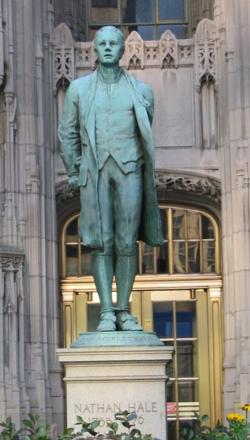
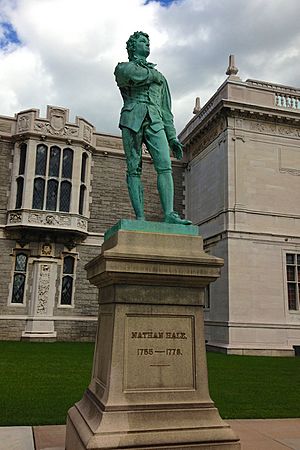

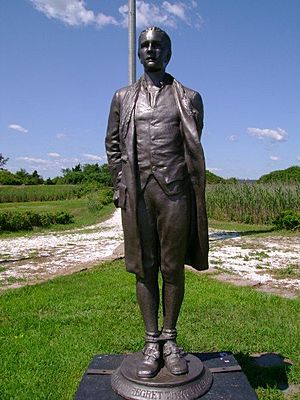

There are many statues of Nathan Hale, but they are based on ideas of what a hero looks like. No real pictures of him from his time have been found. Letters and documents show that Nathan was a smart, practical, and careful person who planned ahead.
Another soldier, Lieutenant Elisha Bostwick, described Nathan Hale. He said Nathan had blue eyes, light blond hair, and darker eyebrows. He was a bit taller than average for his time. Bostwick wrote:
I can now in imagination see his person & hear his voice—his person I should say was a little above the common stature in height, his shoulders of a moderate breadth, his limbs strait & very plump: regular features—very fair skin—blue eyes—flaxen or very light hair which was always kept short—his eyebrows a shade darker than his hair & his voice rather sharp or piercing—his bodily agility was remarkable... his mental powers seemed to be above the common sort—his mind of a sedate and sober cast, & he was undoubtedly Pious...
Two famous statues honor Nathan Hale:
- One statue by Frederick William MacMonnies was put up in 1893 at City Hall Park, New York. This statue created the modern image of Nathan Hale with a strong, square jaw. A copy of this statue is in Williams Park in New London, Connecticut.
- Another statue by Bela Pratt was made between 1908 and 1912. It stands in front of Connecticut Hall at Yale, where Nathan Hale lived as a student. Copies of this statue are in many places, including the Phillips Academy in Andover, Massachusetts, the Connecticut Governor's Residence, Fort Nathan Hale, and the headquarters of the Central Intelligence Agency (CIA).
Other statues and markers include:
- A statue with his reported last words on the first floor of the Connecticut State Capitol in Hartford.
- A memorial in Huntington, New York, where he landed for his spying mission.
- A historical marker in Freese Park, Norwalk, Connecticut, showing where he started his mission.
- A tall stone monument, called the Captain Nathan Hale Monument, was built in his honor in 1846 in his hometown of Coventry, Connecticut.
In 1899, a play about Nathan Hale's life, called Nathan Hale by Clyde Fitch, opened in New York. It was very successful.
Things Named After Nathan Hale
Many places and things are named after Nathan Hale to remember his bravery:
- The small town of Halesite, New York, on Long Island, is named after him.
- Nathan Hale Army Depot, a U.S. Army base, is in Darmstadt, Germany.
- Fort Nathan Hale, a historic fort from the Revolutionary War, is in New Haven, Connecticut.
- Dormitories at the University of Connecticut and Phillips Academy are named after him.
- Nathan Hale Center at Robert Morris University and Nathan Hale Hall at Farmingdale State College are academic buildings.
- The Nathan Hale Memorial Chapter of the Daughters of the American Revolution was started in 1900 at the one-room schoolhouse where he once taught.
- Several high schools and middle schools across the United States are named after Nathan Hale.
- The United States Navy submarine USS Nathan Hale (SSBN-623) was named in his honor.
- The Nathan Hale Ancient Fife and Drum Corps from Coventry, Connecticut, is named after him.
- A Boy Scout camp in New York has a Campsite Nathan Hale.
Songs and Poems About Nathan Hale
Two early songs or poems try to imagine Nathan Hale's last speech. One anonymous "Ballad of Nathan Hale" from 1776 talks about not fearing death. Another poem, "To the Memory of Capt. Nathan Hale," was written by Eneas Munson Sr. soon after Hale's death. Munson had tutored Hale before college and knew him well. His poem describes Hale's strong belief in freedom and his willingness to die for his country.
"Hate of oppression's arbitrary plan,
The love of freedom, and the rights of man;
A strong desire to save from slavery's chain
The future millions of the western main,
And hand down safe, from men's invention cleared,
The sacred truths which all the just revered;
For ends like these, I wish to draw my breath,"
He bravely cried, "or dare encounter death."
And when a cruel wretch pronounced his doom,
Replied, "'Tis well, – for all is peace to come;
The sacred cause for which I drew my sword
Shall yet prevail, and peace shall be restored.
I've served with zeal the land that gave me birth,
Fulfilled my course, and done my work on earth;
Have ever aimed to tread that shining road
That leads a mortal to the blessed God.
I die resigned, and quit life's empty stage,
For brighter worlds my every wish engage;
And while my body slumbers in the dust,
My soul shall join the assemblies of the just."
Images for kids
See also
 In Spanish: Nathan Hale para niños
In Spanish: Nathan Hale para niños






